Djadochta Formation
The Djadochta Formation (sometimes transcribed Djadokhta) is a geological formation situated in central Asia (Gobi Desert), dating from the Late Cretaceous Period. Laid down in the early Campanian, possibly starting in the latest Santonian, it is dated somewhat uncertainly at about 75-71 mya (million years ago).[1] The type locality are the famous "Flaming Cliffs", locally known as Bayanzag ("rich in Haloxylon") or Ulaan-Ereg ("red cliffs").
| Djadochta Formation Stratigraphic range: Campanian, 75–71 Ma | |
|---|---|
| Type | Geological formation |
| Unit of | Shamo Group |
| Sub-units | Bayn Dzak & Tugrugyin members |
| Underlies | Barun Goyot Formation |
| Overlies | Alagteeg Formation |
| Thickness | Over 90 m (composite) |
| Lithology | |
| Primary | Sandstone |
| Other | Mudstone |
| Location | |
| Coordinates | 44°08′19″N 103°43′40″E |
| Approximate paleocoordinates | 30.7°N 9.2°E |
| Region | Mongolia Ömnögov |
| Country | |
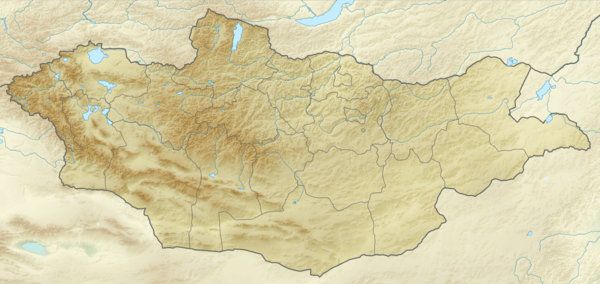 Djadochta Formation (Mongolia) | |
It preserves an arid habitat of sand dunes, with little freshwater apart from oases and arroyos. In fact, the present-day climate at most Djadochta Formation sites differs little from what it was some 80 mya, except by being somewhat warmer and perhaps a bit less arid then. This is testimony to the fact that the location has long been so far from any major source of evaporation that little rainfall reached it, even before the Himalayas were uplifted which bar clouds from reaching today's Gobi desert.
Most notable fossil discoveries have been the first confirmed dinosaur eggs (a clutch, probably of Oviraptor) and several dinosaur finds, Protoceratops, Pinacosaurus and Velociraptor being the most prominent.
Fossil content
The fauna of the Djadochta Formation is very similar in composition to the nearby Bayan Mandahu Formation. The two share many of the same genera, but differ in the exact species. For example, the most common mammal in the Djadochta is Kryptobaatar dashzevegi, while in the Bayan Mandahu, it is the closely related Kryptobaatar mandahuensis. Similarly, the dinosaur fauna of the Djadochta includes Protoceratops andrewsi and Velociraptor mongoliensis, which the Bayan Mandahu yields Protoceratops hellenikorhinus and Velociraptor osmolskae.[1] It is likely that the nearby Bayan Mandahu represents a slightly younger, perhaps by 1 million years, assemblage of slightly more derived animals, possibly the direct descendants of their Djadochta counterparts.[2]
Amphibians
A frog of uncertain classification is known from the formation.
Crocodylomorphs
| Genus | Species | Location | Stratigraphic position | Abundance | Notes |
|---|---|---|---|---|---|
| Gobiosuchus | G. kielanae | A gobisuchid | |||
| Shamosuchus | S. djadochtaensis | A mesoeucrocodylian | |||
| Zaraasuchus | Z. shepardi | A gobisuchid | |||
| Zosuchus | Z. davidsoni | A basal crocodyliform | |||
Lizards
| Genus | Species | Location | Stratigraphic position | Abundance | Notes | Images |
|---|---|---|---|---|---|---|
| Aiolosaurus | A. oriens | |||||
| Anchaurosaurus | A. gilmorei | A primitive iguanid | ||||
| Estesia | E. mongoliensis | A varanid | ||||
| Gobiderma | G. pulchra | An anguimorph | ||||
| Mimeosaurus | M. crassus | An agamid | ||||
| Pleurodontagama | P. aenigmatodes | An agamid | ||||
| Priscagama | P. gobiensis | An agamid | ||||
| Saichangurvel | S. davidsoni | A gobiguanian iguanid | ||||
| Telmasaurus | T. grangeri | A varanid | ||||
| Xihaina | X. aquilonia | A primitive iguanid | ||||
Mammals
| Genus | Species | Location | Stratigraphic position | Abundance | Notes | Images |
|---|---|---|---|---|---|---|
| Bulganbaatar | B. nemegtbaataroides | A multituberculate | ||||
| Deltatheridium | D. pretrituberculare | A metatherian | ||||
| Deltatheroides | D. cretacicus | A metatherian | ||||
| Hyotheridium | H. dobsoni | A therian mammal of uncertain classification | ||||
| Kamptobaatar | K. kuczynskii | Ukhaa Tolgod | A multituberculate | |||
| Kennalestes | K. gobiensis | A eutherian. Also present in the Bayan Mandahu Formation. | ||||
| Kryptobaatar | K. dashzevegi | A multituberculate, the most common mammal in this formation.[1] | ||||
| Zalambdalestes | Z. lechei | A eutherian | 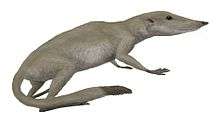 | |||
Ornithischians
| Genus | Species | Location | Abundance | Notes | Images |
|---|---|---|---|---|---|
| Minotaurasaurus | M. ramachandrani | Ukhaa Tolgod[4][5] | An ankylosaurid |  | |
| Pinacosaurus | P. grangeri | An ankylosaurid |  | ||
| P. mephistocephalus | Bayan Mandahu | ||||
| Indeterminate | Tugriken Shireh[2] | An ankylosaurid | |||
| Plesiohadros[6] | P. djadokhtaensis | Alag Teg | A hadrosauroid | ||
| Protoceratops | P. andrewsi | A protoceratopsid | 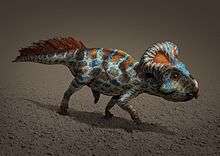 | ||
| P. hellenikorhinus | Bayan Mandahu | ||||
| Indeterminate | Ukhaa Tolgod[2] | A protoceratopsid | |||
| Udanoceratops | U. tschizhovi | Udan-Sahr |  | ||
Saurischians
| Saurischian dinosaurs | ||||||
|---|---|---|---|---|---|---|
| Genus | Species | Location | Material | Notes | Images | |
| Aepyornithomimus[7] | A. tugrikinensis | Tögrögiin Shiree | An ornithomimid | 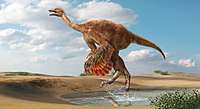 | ||
| Almas[8] | A. ukhaa | Ukhaa Tolgod | A troodontid |  | ||
| Apsaravis[9] | A. ukhaana[9] | Ukhaa Tolgod[10] | "Partial postcranial skeleton."[11] | A basal ornithurine bird | ||
| Archaeornithoides[9] | A. deinosauriscus[9] | Bayn Dzak[12] | "Partial skull."[13] | A coelurosaur of uncertain relationships | ||
| Byronosaurus[9] | B. jaffei[9] | Ukhaa Tolgod[2] | "Skull and fragmentary postcranium, [and a] fragmentary skull."[14] | A troodontid |  | |
| Citipati[9] | C. osmolskae[9] | Ukhaa Tolgod[2] | "Skeleton with skull, partial postcranium, embryo to adult."[15] | An oviraptorid | 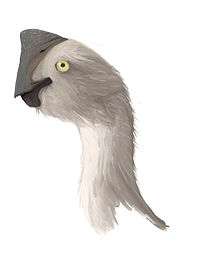 | |
| Citipati sp. | Zamyn Khondt[2] | An oviraptorid with a distinctive, tall crest | 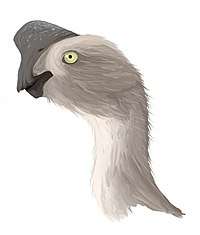 | |||
| Gobipteryx | G. minuta | Ukhaa Tolgod | An enantiornithine. Also known from the Barun Goyot Formation. | |||
| Gobivenator | G. mongoliensis | "Almost complete skeleton." [16] | A troodontid theropod |  | ||
| Halszkaraptor[17] | H. escuilliei | Ukhaa Tolgod[2] | A dromaeosaurid |  | ||
| Khaan | K. mckennai | Ukhaa Tolgod[2] | "[Three] skeletons with skulls."[15] | An oviraptorid | 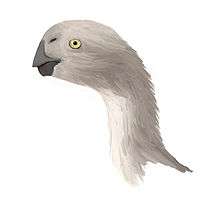 | |
| Kol | K. ghuva | Ukhaa Tolgod[18] | "A well-preserved right foot"[18] | An alvarezsaurid |  | |
| Mahakala | M. omnogovae | Tugriken Shireh[2] | A dromaeosaurid | 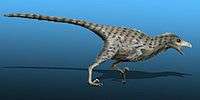 | ||
| Oviraptor[19] | O. philoceratops[19] | Bayan Dzak[2] | "[One] partial skeleton with skull"[20] | An oviraptorid | 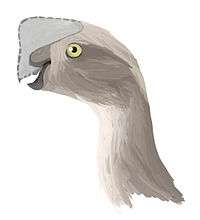 | |
| ?Parvicursor | Indeterminate | Tugriken Shireh[2] | An alvarezsaurid | 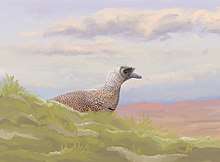 | ||
| Saurornithoides[19] | S. mongoliensis[19] | Bayan Dzak[2] | "Skull with fragmentary postcranial skeleton."[14] | A troodontid |  | |
| Shuvuuia[9] | S. deserti[9] | "Skull and postcranial skeleton."[21] | An alvarezsaurid | 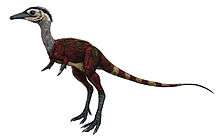 | ||
| cf. Tarbosaurus[22] | Indeterminate[22] | A tyrannosaurid, may actually be Zhuchengtyrannus.[22] | ||||
| Tyrannosauridae indet. | Indeterminate[19] | A tyrannosaurid possibly referable to Alectrosaurus | ||||
| Tsaagan | T. mangas | Ukhaa Tolgod[2] | A dromaeosaurid | 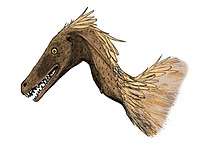 | ||
| Velociraptor[19] | V. mongoliensis[19] | A dromaeosaurid | 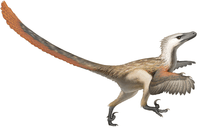 | |||
| cf. Zhuchengtyrannus[22] | Indeterminate[22] | A tyrannosaurid, may actually be Tarbosaurus.[22] | ||||
| Unnamed dromaeosaurid | Unnamed | Zos wash[3] | ||||
| Unnamed troodontid | Unnamed, specimen IGM 100/1005 | Ukhaa Tolgod[3] | ||||
|
Ornithomimosauria indet. |
Unnamed, specimen IGM 100/1245 and IGM 100/987 |
|
skull fragments[24] |
|||
Color key
|
Notes Uncertain or tentative taxa are in small text; |
Eggs
| Oogenus | Oospecies | Location | Material | Notes |
|---|---|---|---|---|
| Styloolithus[25] | S. sabathi | Bayn Dzak[25] | Probably avian | |
| Protoceratopsidovum[26] |
|
|||
| Elongatoolithus[26] |
|
|||
| Spheroolithus[26] |
|
|||
| Macroolithus[26] | M. mutabilis | |||
| Subtiliolithus[26] | spp. | |||
Panorama
See also
- List of dinosaur-bearing rock formations
- List of fossil sites (with link directory)
- Barun Goyot Formation
- Nemegt Formation
References
- Godefroit, Pascal; Currie, Philip J.; Li, Hong; Shang, Chang Yong; Dong, Zhi-ming (2008). "A new species of Velociraptor (Dinosauria: Dromaeosauridae) from the Upper Cretaceous of northern China". Journal of Vertebrate Paleontology. 28 (2): 432–438. doi:10.1671/0272-4634(2008)28[432:ANSOVD]2.0.CO;2.
- Nicholas R. Longrich; Philip J. Currie; Dong Zhi-Ming (2010). "A new oviraptorid (Dinosauria: Theropoda) from the Upper Cretaceous of Bayan Mandahu, Inner Mongolia". Palaeontology. 53 (5): 945–960. doi:10.1111/j.1475-4983.2010.00968.x.
- Norell, M.A.; Clark, J.M.; Turner, A.H.; Makovicky, P.J.; Barsbold, R.; Rowe, T. (2006). "A new dromaeosaurid theropod from Ukhaa Tolgod (Omnogov, Mongolia)". American Museum Novitates. 3545: 1–51. doi:10.1206/0003-0082(2006)3545[1:ANDTFU]2.0.CO;2. hdl:2246/5823. ISSN 0003-0082.
- Alicea, J.; Loewen, M. (2013). "New Minotaurasaurus material from the Djodokta Formation establishes new taxonomic and stratigraphic criteria for the taxon". Journal of Vertebrate Paleontology. Program and Abstracts: 76.
- Penkalski, P.; Tumanova, T. (2017). "The cranial morphology and taxonomic status of Tarchia (Dinosauria: Ankylosauridae) from the Upper Cretaceous of Mongolia". Cretaceous Research. 70: 117–12. doi:10.1016/j.cretres.2016.10.004.
- Khishigjav Tsogtbaatar, David Weishampel, David C. Evans, and Mahito Watabe (2014). A new hadrosauroid (Plesiohadros djadokhtaensis) from the Late Cretaceous Djadokhtan fauna of southern Mongolia. [pgs. 108-135] In: David A. Eberth and David C. Evans (eds). Hadrosaurs. Proceedings of the International Hadrosaur Symposium. Indiana University Press. ISBN 978-0-253-01385-9.
- Chinzorig, T.; Kobayashi, Y.; Tsogtbaatar, K.; Currie, P. J.; Watabe, M.; Barsbold, R. (2017). "First Ornithomimid (Theropoda, Ornithomimosauria) from the Upper Cretaceous Djadokhta Formation of Tögrögiin Shiree, Mongolia". Scientific Reports. 7 (5835). Bibcode:2017NatSR...7.5835C. doi:10.1038/s41598-017-05272-6. PMC 5517598. PMID 28724887.
- Pei, R.; Norell, M.A.; Barta, D.E; Bever, G.S.; Pittman, M.; Xu, Xing (2017). "Osteology of a New Late Cretaceous Troodontid Specimen from Ukhaa Tolgod, Ömnögovi Aimag, Mongolia". American Museum Novitates. 3889 (3889): 1–47. doi:10.1206/3889.1.
- "47.4 Ömnögov', Mongolia; 2. Djadochta Formation." Weishampel, et al. (2004). Pg. 596.
- Clarke, Julia A., Norell, Mark A. (2002). "The morphology and phylogenetic position of Apsaravis ukhaana from the Late Cretaceous of Mongolia". American Museum Novitates, No. 3387, American Museum of Natural History, New York, NY.
- "Table 11.1," in Weishampel, et al. (2004). Page 214.
- Spelled "Ömnögov'" in "47.4 Ömnögov', Mongolia; 2. Djadochta Formation." Weishampel, et al. (2004). Pg. 596.
- "Table 4.1," in Weishampel, et al. (2004). Page 76.
- "Table 9.1," in Weishampel, et al. (2004). Page 185.
- "Table 8.1," in Weishampel, et al. (2004). Page 167.
- Tsuihiji, T.; Barsbold, R.; Watabe, M.; Tsogtbaatar, K.; Chinzorig, T.; Fujiyama, Y.; Suzuki, S. (2014). "An exquisitely preserved troodontid theropod with new information on the palatal structure from the Upper Cretaceous of Mongolia". Naturwissenschaften. 101 (2): 131–142. doi:10.1007/s00114-014-1143-9. PMID 24441791.
- Cau, A.; Beyrand, V.; Voeten, D.; Fernandez, V.; Tafforeau, P.; Stein, K.; Barsbold, R.; Tsogtbaatar, K.; Currie, P.; Godefroit, P. (2017). "Synchrotron scanning reveals amphibious ecomorphology in a new clade of bird-like dinosaurs". Nature.
- Turner, A.H.; Nesbitt, S.J.; Norell, M.A. (2009). "A Large Alvarezsaurid from the Cretaceous of Mongolia". American Museum Novitates. 3648: 1–14. doi:10.1206/639.1. hdl:2246/5967.
- "48.11 Nei Mongol Zizhiqu, People's Republic of China; 2. Djadochta Formation." Weishampel, et al. (2004). Pg. 598.
- "Table 8.1," in Weishampel, et al. (2004). Page 166.
- "Table 11.1," in Weishampel, et al. (2004). Page 211.
- Mortimer, M (2004). "Tyrannosauroidea". The Theropod Database. Archived from the original on 2013-09-29. Retrieved 2007-08-21.
- "Inner Mongolia" is referred to as "Nei Mongol Zizhiqu" in "48.11 Nei Mongol Zizhiqu, People's Republic of China; 2. Djadochta Formation." Weishampel, et al. (2004). Pg. 598.
- Ksepka, Daniel T.; Norell, Mark A. (2004). "Ornithomimosauria cranial material from Ukhaa Tolgod (Omnogov, Mongolia)". American Museum Novitates. 3448: 1–4. doi:10.1206/0003-0082(2004)448<0001:ocmfut>2.0.co;2. hdl:2246/2813. ISSN 0003-0082.
- Varricchio, D.J.; Barta, D.E. (2015). "Revisiting Sabath's "Larger Avian Eggs" from the Gobi Cretaceous". Acta Palaeontologica Polonica. 60 (1): 11–25.
- Mikhailov, K. E. (1995) "Systematic, faunistic and stratigraphic diversity of Cretaceous eggs in Mongolia: comparison with China." Sixth Symposium on Mesozoic Terrestrial Ecosystems and Biota, Beijing. Short Papers... Beijing. pp. 165-168.
Bibliography
- Weishampel, David B.; Peter Dodson, and Halszka Osmólska (eds.). 2004. The Dinosauria, 2nd edition, 1–880. Berkeley: University of California Press. Accessed 2019-02-21. ISBN 0-520-24209-2
